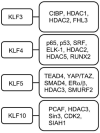Kruppel-like Factors in Skeletal Physiology and Pathologies
- PMID: 36499521
- PMCID: PMC9741390
- DOI: 10.3390/ijms232315174
Kruppel-like Factors in Skeletal Physiology and Pathologies
Abstract
Kruppel-like factors (KLFs) belong to a large group of zinc finger-containing transcription factors with amino acid sequences resembling the Drosophila gap gene Krüppel. Since the first report of molecular cloning of the KLF family gene, the number of KLFs has increased rapidly. Currently, 17 murine and human KLFs are known to play crucial roles in the regulation of transcription, cell proliferation, cellular differentiation, stem cell maintenance, and tissue and organ pathogenesis. Recent evidence has shown that many KLF family molecules affect skeletal cells and regulate their differentiation and function. This review summarizes the current understanding of the unique roles of each KLF in skeletal cells during normal development and skeletal pathologies.
Keywords: Kruppel-like factor; osteoarthritis; osteoblast; osteoclast; osteoporosis; osteosarcoma.
Conflict of interest statement
The authors declare no conflict of interest. The funders had no role in the design of the study; in the collection, analyses, or interpretation of data; in the writing of the manuscript; or in the decision to publish the results.
Figures


Similar articles
-
KLF transcription factors in bone diseases.J Cell Mol Med. 2024 Apr;28(8):e18278. doi: 10.1111/jcmm.18278. J Cell Mol Med. 2024. PMID: 38546623 Free PMC article. Review.
-
Porcine KLF gene family: Structure, mapping, and phylogenetic analysis.Genomics. 2010 Feb;95(2):111-9. doi: 10.1016/j.ygeno.2009.11.001. Epub 2009 Nov 23. Genomics. 2010. PMID: 19941950
-
Embryonic expression of the chicken Krüppel-like (KLF) transcription factor gene family.Dev Dyn. 2010 Jun;239(6):1879-87. doi: 10.1002/dvdy.22318. Dev Dyn. 2010. PMID: 20503383 Free PMC article.
-
Sp1- and Krüppel-like transcription factors.Genome Biol. 2003;4(2):206. doi: 10.1186/gb-2003-4-2-206. Epub 2003 Feb 3. Genome Biol. 2003. PMID: 12620113 Free PMC article. Review.
-
The biology of the mammalian Krüppel-like family of transcription factors.Int J Biochem Cell Biol. 2000 Nov-Dec;32(11-12):1103-21. doi: 10.1016/s1357-2725(00)00059-5. Int J Biochem Cell Biol. 2000. PMID: 11137451 Free PMC article. Review.
Cited by
-
Krüppel-like Factor-9 and Krüppel-like Factor-13: Highly Related, Multi-Functional, Transcriptional Repressors and Activators of Oncogenesis.Cancers (Basel). 2023 Nov 30;15(23):5667. doi: 10.3390/cancers15235667. Cancers (Basel). 2023. PMID: 38067370 Free PMC article. Review.
-
Krüppel-like factors family in health and disease.MedComm (2020). 2024 Sep 10;5(9):e723. doi: 10.1002/mco2.723. eCollection 2024 Sep. MedComm (2020). 2024. PMID: 39263604 Free PMC article. Review.
-
Exploring the Functionality of the Krüppel-like Factors in Kidney Development, Metabolism, and Diseases.Life (Basel). 2024 Dec 17;14(12):1671. doi: 10.3390/life14121671. Life (Basel). 2024. PMID: 39768378 Free PMC article. Review.
-
Dynamics of DNA methylation during osteogenic differentiation of porcine synovial membrane mesenchymal stem cells from two metabolically distinct breeds.Epigenetics. 2024 Dec;19(1):2375011. doi: 10.1080/15592294.2024.2375011. Epub 2024 Jul 2. Epigenetics. 2024. PMID: 38956836 Free PMC article.
-
The Role of Krüppel-like Factors in Pancreatic Physiology and Pathophysiology.Int J Mol Sci. 2023 May 11;24(10):8589. doi: 10.3390/ijms24108589. Int J Mol Sci. 2023. PMID: 37239940 Free PMC article. Review.
References
Publication types
MeSH terms
Substances
Grants and funding
LinkOut - more resources
Full Text Sources
Miscellaneous

